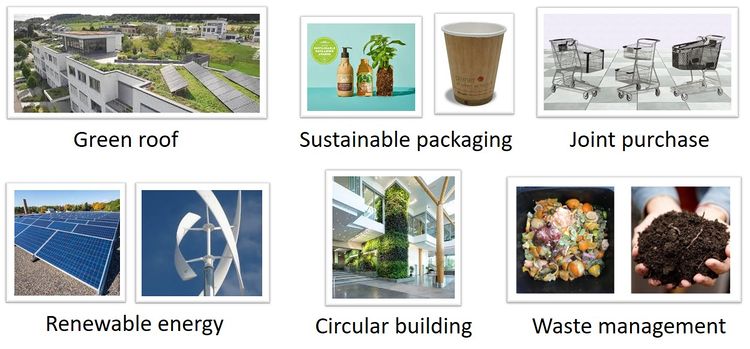Geen bewerkingssamenvatting |
Geen bewerkingssamenvatting |
||
| Regel 22: | Regel 22: | ||
Through the value chain meetings and ‘calls for proposals’ several project ideas have been identified by local entrepreneurs that joined the FACET-initiative. The best solutions that enable a shift from a linear to a circular economy are selected and turned into projects, focused on topics such as renewable energy, circular/bio-based building, sustainable packaging, green roofs, waste management, and others. In addition, FACET has initiated two pilot projects on bio-based building.↵The selected project ideas are ideally clustered together for joint-development around the solution topics. Good examples are shared including custom developed FACET-models & tools to enhance the strength of entrepreneurs making their project ideas come to life and fruition. | Through the value chain meetings and ‘calls for proposals’ several project ideas have been identified by local entrepreneurs that joined the FACET-initiative. The best solutions that enable a shift from a linear to a circular economy are selected and turned into projects, focused on topics such as renewable energy, circular/bio-based building, sustainable packaging, green roofs, waste management, and others. In addition, FACET has initiated two pilot projects on bio-based building.↵The selected project ideas are ideally clustered together for joint-development around the solution topics. Good examples are shared including custom developed FACET-models & tools to enhance the strength of entrepreneurs making their project ideas come to life and fruition. | ||
[[Bestand:FACET theme's.jpg|gecentreerd|miniatuur|750x750px|FACET theme's]] | [[Bestand:FACET theme's.jpg|gecentreerd|miniatuur|750x750px|FACET theme's]] | ||
{{Project | {{Project | ||
|Name=Quadrupal Helix | |Name=Quadrupal Helix | ||
| Regel 45: | Regel 44: | ||
|Type=Theory | |Type=Theory | ||
|Imagename=Shaking hands.jpg | |Imagename=Shaking hands.jpg | ||
}} | }}The selected project ideas are ideally clustered together for joint-development around the solution topics. Good examples are shared including custom developed FACET-models & tools to enhance the strength of entrepreneurs making their project ideas come to life and fruition. | ||
Versie van 13 apr 2021 06:33
Introduction
Our research program is aimed at joint-development of project ideas and pilots from entrepreneurs, while building the social network around them for successful design and implementation[1]. To enhance this, we are creating a - scientific based - practical toolkit for the implementation of CE-solutions and are building the FACET-community.
Quadrupal Helix
Within FACET we are connecting several stakeholders and experts around topics like renewable energy, resource & waste management, bio-based building, green roofs, joint-purchase, and sustainable packaging. The reason is two-fold: driving innovation is easier when working together and optimizing informal and formal regional networks helps strengthening local economic activities. Regions must build on their own strengths by connecting government, business, academia and civil society, an approach also called Quadrupal Helix.
It is a method to enhance the cooperation between relevant stakeholders that are linked to the entrepreneurial process[2], in this case entrepreneurs in the Tourism & Leisure sector that want to become more sustainable. The Quadruple Helix entails several meetings that focuses on how to foster an innovative environment for organizations and help them to develop better products and services. As such, partners in the Quadrupal Helix strive to have a positive effect on business climate and society in general.
The FACET-partnership
The FACET project involves representatives from public authorities, industry, academia and citizens. The actors vary amongst the regions (see map):
- Public authorities: include (local and regional) government and policy makers t.b.d.
- Business & Industry: includes local businesses, for example restaurants, hotels and campings, as well as vacation parks (Paardenkreek/NL). Industry representatives and regional development agencies are in France (Dir. Régionale Hauts-de-France de l’ADEME), Belgium (The Blue Cluster & Westtoer), United Kingdom (Norfolk City Council) and The Netherlands (Economic Impulse Zeeland).
- Academia: includes universities or research & development bodies such as the University of Greenwich (UK) and HZ University of Applied Sciences/Knowledge Center for Coastal Tourism (NL).
- Civil society are the fourth actor of the Quadruple Helix and often refers to how users and citizens are invited via media, information campaigns and other channels. Citizens in the innovation process ideally consists of different representatives of the end-user and/or voluntary organizations and volunteers.
.
Opportunities
Through the value chain meetings and ‘calls for proposals’ several project ideas have been identified by local entrepreneurs that joined the FACET-initiative. The best solutions that enable a shift from a linear to a circular economy are selected and turned into projects, focused on topics such as renewable energy, circular/bio-based building, sustainable packaging, green roofs, waste management, and others. In addition, FACET has initiated two pilot projects on bio-based building.↵The selected project ideas are ideally clustered together for joint-development around the solution topics. Good examples are shared including custom developed FACET-models & tools to enhance the strength of entrepreneurs making their project ideas come to life and fruition.
The selected project ideas are ideally clustered together for joint-development around the solution topics. Good examples are shared including custom developed FACET-models & tools to enhance the strength of entrepreneurs making their project ideas come to life and fruition.




